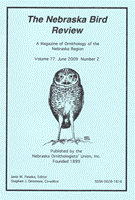Nebraska Ornithologists' Union

Nebraska Bird Review
Date of this Version
5-2017
Document Type
Article
Citation
The Nebraska Bird Review Vol. 85 No. 2 (2017), pp 54-83
Abstract
In general, this was a routine spring, except for remarkable numbers reported of several species, and a notable paucity of most species of wood-warblers. A huge Snow Goose flock in the east was estimated to contain 500,000- 1,000,000 birds; other notable numbers were 2000 Tree Swallows and 5000 Cliff Swallows, both record counts, 44 Black-capped Chickadees, 300 House Wrens, 62 Fox and 76 Song Sparrows on the same day at a single location, 168 Dark-eyed (Slate-colored) Juncos, and 10,000 Common Grackles. Perhaps the most notable phenomenon this spring was the dearth of migrant wood-warblers. Joel Jorgensen constructed graphics based on raw data (“crude counts”) posted to eBird that showed large negative changes between 2016 and 2017 in number of individuals reported and high counts reported; high counts for 11 species declined on average an amazing 80%; the decline was consistent in magnitude for all 11 species. Jorgensen suggested this might have resulted from weather patterns that pushed migrants eastward; numbers of warblers in Iowa appeared to be normal. Other interesting phenomena included increasing numbers of Black-bellied Whistling-Ducks, a Long-eared Owl nest, increasing reports of Dusky Flycatcher, and a large rather early influx of White-faced Ibis in the east. Rarities were few, led by the long-staying Golden-crowned Sparrow in Knox Co, Nebraska’s 6th, the first Panhandle record of Blue-headed Vireo, and 10th state record of Curve-billed Thrasher.
Included in
Ornithology Commons, Population Biology Commons, Poultry or Avian Science Commons, Zoology Commons


Comments
Published by the Nebraska Ornithologists’ Union, Inc.